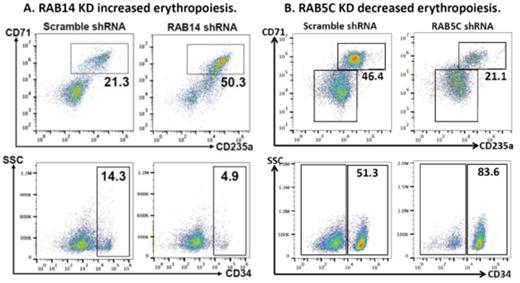Abstract
Previously, we reported that the erythroid-expressed miRs, miR-144 and miR-451, target the RAB14 GTPase during human erythropoiesis in the human TF1 erythropoietic model cell line and in primary CD34+ hematopoietic stem-progenitor cells. In response to erythropoietin, endogenous RAB14 levels decreased during erythropoiesis, and RAB14 knockdown increased the numbers of erythroid (CD34- CD71hi CD235ahi) cells, increased b-hemoglobin expression, and decreased ETO2 expression (Kim, BJH, 2015). Taken together, our findings revealed that RAB14 functions as a physiologic inhibitor of human erythropoiesis. RAB GTPases comprise a >60 member subfamily of the large RAS oncogene family, and multiple RAB GTPases play important roles in vesicle trafficking, signal transduction and receptor recycling. RAB14 is a component of the intermediate compartment of the endosomal recycling pathway, between the RAB4/RAB5-dependent early endosome and the RAB11-dependent recycling endosome (Linford, Dev. Cell, 2012). The RAB GTPases are responsible for directing cargo proteins to the recycling vs. degradation pathway during endosome maturation. To test the role of another endosomal RAB GTPases in human erythropoiesis, we examined the consequences of knocking down RAB5 protein levels. In contrast to our findings with RAB14, knockdown of RAB5C decreased the numbers of erythroid cells generated during erythropoiesis, indicating that RAB5C enhances physiologic erythropoiesis. Consistent with this observation, mRNA and protein levels for all three RAB5 isoforms (i.e. RAB5A, B, C) increased during erythropoiesis. The opposing erythropoietic effects of RAB14 and RAB5 GTPases may be due to their contrary roles in endosomal recycling, in that internalization of cell surface receptors is dependent on RAB5 GTPase, whereas RAB14 GTPase is involved in recycling of receptors back to the cell surface.
No relevant conflicts of interest to declare.
Author notes
Asterisk with author names denotes non-ASH members.


This feature is available to Subscribers Only
Sign In or Create an Account Close Modal